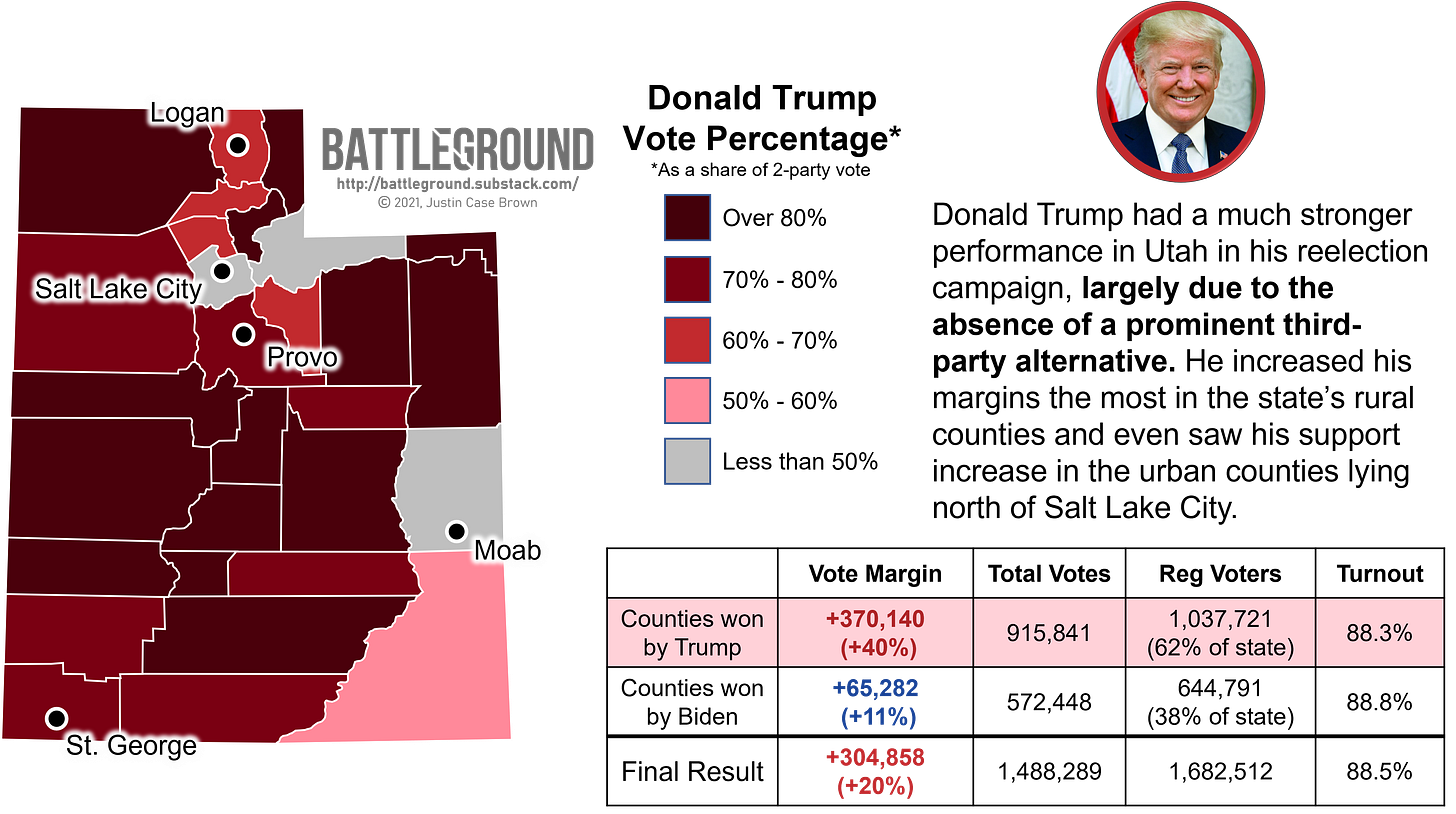Utah: Reluctant Trumpers v. Never Trumpers
"Hi, can I please get an Evan McMuffin...? wait... You took it off the menu?"
Topline Takeaways
In 2016, roughly 1 in 4 Utah voters chose to support a third-party candidate for president. In 2020, that dropped to 1 in 20 as most voters acquiesced to the two-party system.
While Trump benefited from the absence of a conservative third-party challenger, he still scored the smallest statewide margin for a Republican candidate since George H.W. Bush in 1992.
Pres. Joe Biden became the first Democratic presidential candidate to win a majority of votes in Salt Lake county since Lyndon B. Johnson in 1964.
In-Depth Insights
Utah has been a Republican stronghold for decades; the last time a Democrat presidential candidate won the state was Lyndon B. Johnson in 1964. For a brief moment in 2016, it looked as though the candidacy of Donald Trump would snap the state’s Republican winning streak as he was initially unpopular among the state’s large Mormon population. Unfortunately for Democrats, much of Utah’s electorate has come around on Trump following his tenure in the White House (as of May 2021, nearly half of all Mormons believe in Trump’s “big lie” that the election was stolen from him). Much like in Idaho to its north, the majority of Utah’s voting base identifies as conservative, in part due to high levels of religious adherence among the state’s Mormon population.
Unfortunately for Republicans, many in the Mormon church are reckoning with the GOP’s courtship of right-wing extremists and see increasing incompatibility with the history of the church. The primary reason Mormons are so prevalent in Utah is due to their history as a persecuted minority, being forced out of states in the Midwest. As a result, many within the church have forcefully denounced white supremacy and hold liberal views on civil rights for refugees, immigrants and even LGBT residents. (Utah is one of few states in the nation that has passed legislation barring discrimination against LGBT residents in housing and jobs.) This further complicates Republican prospects as recent shifts within the party have promoted a more exclusive, rather than inclusive political environment.
-Dallin Oaks, a prominent leader within the Mormon church
Utah is currently one of the fastest growing states in the nation, with the St. George and Provo-Orem metropolitan areas ranking as the fifth and ninth fastest growing American metros, respectively. Meanwhile, membership numbers for The Church of Jesus Christ of Latter-day Saints are down. In 2019, Utah saw the smallest growth in its Mormon population in three decades with roughly half of its counties seeing Mormon populations decline. Therefore many, if not most, of the state’s new residents don’t subscribe to the religiously-motivated conservative mindset that the state is often known for. These changes are already producing results: Pres. Joe Biden became the first Democratic presidential candidate to win a majority of votes in the state’s most populous county, Salt Lake county, since LBJ’s statewide win in 1964. He also is one of only three Democratic candidates to win more than two counties in a single election, flipping Grand county after Clinton’s loss there in 2016.
Forecasting the Future: In 2016, Utah was one of a few states that supported third-party candidates by large margins. Evan McMullin, a former CIA operations officer from Utah, ran as an independent candidate and garnered over 21% of the statewide vote. While this complicates data comparisons between the 2016 and 2020 elections (less than 5% of voters backed third party candidates in 2020), it provides a rare look into how independent voters transpose onto the two-party vote. The map above shows that most of the 2016 third-party voters came from the populous northern counties of the state surrounding the Great Salt Lake. The map below looks at how each county shifted as a result of those third-party voters opting for Democrats or Republicans in the 2020 election.
The majority of counties saw large rises in support for Trump in 2020 as third-party support disappeared. Amongst those more populous northern counties only Salt Lake county and Summit county saw shifts toward Democrats. Despite the fact that Evan McMullin explicitly ran a “Never Trump” campaign, attempting to cast himself as a conservative alternative, the majority of his voters came around to supporting Donald Trump in 2020. Trump’s statewide percentage of the vote increased by 13 points while Biden only scored 10 points higher than Clinton without a “Never Trump” option on the ballot.
The political future of presidential politics in Utah depends on how far the national Democratic party shifts to the left. While many voters within the state have already admonished the Republican party’s Trump-y turn, they’re also equally turned off by the increasingly liberal lean of today’s Democratic party. Joe Biden proved that a more moderate approach can help build a coalition for Democrats within the state but Republicans still have a long way to fall before Utah will truly be competitive on the national stage.







